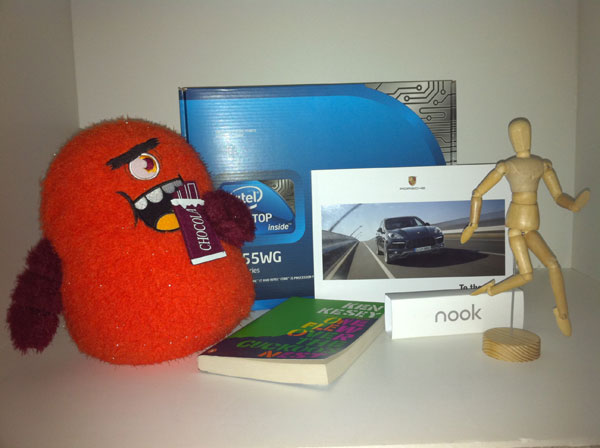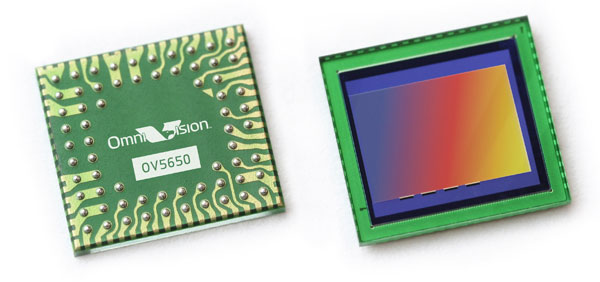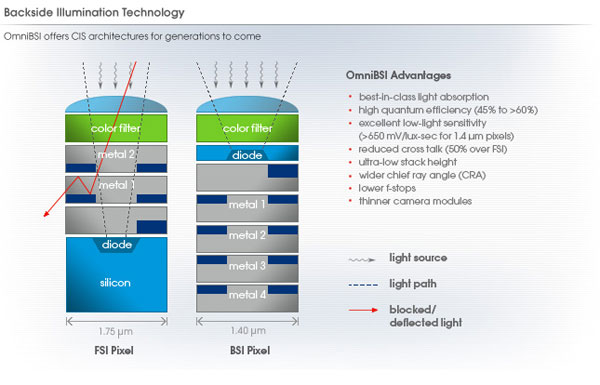Apple's iPhone 4: Thoroughly Reviewed
by Brian Klug & Anand Lal Shimpi on June 30, 2010 4:06 AM EST- Posted in
- Smartphones
- Apple
- iPhone 4
- Gadgets
- Mobile
Welcome to 2010, Apple Upgrades its Camera
The iPhone 4 is equipped with two cameras: a 5 megapixel camera with LED flash on the back of the phone and a VGA camera with no flash on the front. The LED flash works in both still and video modes. Like the EVO 4G, the iPhone 4‘s flash allows you to shoot in perfect darkness. If you’re filming a video in low light the LED will stay illuminated while you’re recording.

Taken with the iPhone 4 in total darkness
The same unfortunately can’t be said for the front facing camera on the 4. In anything but good lighting you’re going to get noise. It’s really only useful for FaceTime (or as an alternative to a mirror) and even then you need to be well lit for it to look decent.
Apple has opted for a 5 megapixel OmniVision sensor for the rear camera on the iPhone 4. What's interesting is that Apple has decided to bring backside illumination front and center with their marketing.
Backside illumination improves the sensitivity of CMOS and CCD detectors by reducing the amount of material in the path of incident light. In a frontside illuminated detector, a considerable amount of light is lost due to absorption that doesn't result in emission of an electron, in addition to reflection off pixel structures and electrical components near the frontside surface. Backside illumination greatly improves sensitivity by flipping the stack over. Instead of light having to pass through and possibly be reflected by metal structures, it is converted into electrons and read out by passing solely through silicon. Creating a backside illuminated part isn't as simple as flipping a sensor over, however, as manufacturers also generally thin the silicon light has to pass through before it can reach the photodiode. This further improves sensitivity and is generally accomplished through chemical etching in acid or by lapping (physically grinding) sensors at wafer scale.

OmniVision OV5650 - iPhone 4's rear camera SoC
Though backside illumination (BSI) improves quantum efficiency (how many photons are converted into electons), backside illumination is hugely important for another serious reason as well. Because the sensor is small at 4.6 mm by 3.4 mm, pixel size is also extremely small at just 1.75 microns square for the OV5650 in the iPhone 4 (state of the art sensors are 1.4 microns square, like those in the HTC Incredible's 8 MP sensor). Frontside illuminated parts generally have in the neighborhood of 10-15 microns of silicon before the active region of the photodiode where one wants photons to get converted to electrons. The result is that without backside illumination, pixels have a 10:1 ratio of height to length, you can visualize them as looking something like long square pillars. But that's a problem.
As photons are converted into electrons in that silicon, there's no guarantee that it will immediately travel down into the gate structure below to be read out by the camera. Electrons drift as they descend these columns, meaning that photons incident on one pixel don't necessarily map to the gate below. Because the smartphone camera sensors are so small, with a 10:1 ratio of height to size, the result is large amounts of so-called quantum blurring from electrons traveling into the gate structures of adjacent pixels. The result is a blurry image (and a decrease in MTF at the sensor level!), thus not representing the image that used to be incident on the sensor.
OmniVision and other smartphone CMOS sensor manufacturers thin that column down in an effort to come closer to having the pixel look more like a cube than a huge pillar. Ballpark numbers are between 3 and 6 microns, down from 10-15. The result is much more sensitive sensors that are higher resolution. While megapixels don't necessarily matter, neither does pixel size as much anymore; it's all about quantum efficiency, which is what engineers really care about.

OmniVision BSI - Courtesy OmniVision
The optical system of the iPhone 4 is difficult to characterize without disassembly, though the focal length is a bit shorter than previous iPhones. The result is that the photos are demonstrably wider angle. Backside illumination also allows for a bigger chief ray angle, higher numerical aperture (and thus lower f/#), but I won't bore you with the details.










270 Comments
View All Comments
Brian Klug - Wednesday, June 30, 2010 - link
I've read your commentary but don't see how we're in disagreement, about anything to be honest. I know for a fact that Apple is reporting RSSI (signal strength) in dBm and not using SNR. You'll just have to trust me that this is the case ;). This is entirely the point of the section - to illustrate just how useless that metric is especially in the case of the iPhone 4, and how much they need to use a different quality metric like CQI.In addition, this: "Because cellular carriers don't want clients to see less than 5 bars, so they have been pretty much rigged to display 5 bars in most situations until the signal is VERY BAD."
Is exactly what I've stated, a few times in so many words in the article. In fact, it's that kind of blatant lying about the dynamic range which makes this effect even more exacerbated. I realize that carriers have a vested interest in making the network look great everywhere - but turns out this ended up biting apple back with the iPhone 4 for reasons I stated.
I agree that normally -107 dBm of signal is bad, but have reason to believe that the iPhone 4's baseband deals just fine with the link even at that signal. Definitely grab someone's iPhone and try it out at -107 and -113; the amount of success I've had is unparalleled compared to other UMTS handsets I've played with.
-Brian
fhaddad922 - Wednesday, June 30, 2010 - link
The subject says it all, but I'll type it again for the slow.If you have any type of "smart" phone (I have no idea whats so "smart" about it) and you are paying $100+ per month to use it, you are really dumb. The only smart people are the ones that convinced you to buy this crap!
Now, if you are some type of a business owner and you need to keep in contact with employees or customers or something similar, than by all means, purchase one of these phones and use it.
But for the rest of the world (which is probably 90% of the readers here), why the f**k do you need a $100+ / month plan?
The phone does nothing that you need. Stop making the cell phone companies richy.
They talk about how good the camera is on it... IT SUCKS!
They talk about how good the video is on it... IT SUCKS!
They talk about how you have to hold the phone the right away... I bet one of the designers said "oops"
FaceTime.. lawl... really?
They are already gouging their customers. For example, to charge $0.25 to send a text message is asinine. It's not even $0.50 to put a letter in the mail and mail it across the country. How do they justify $0.25 to send a text message? On top of that, for $50.00 / month and you don't get unlimited calling. Thats dumb.
strikeback03 - Thursday, July 1, 2010 - link
Thank you for the anti-capitalist rantpetzi-bear - Wednesday, June 30, 2010 - link
Have you tried it with a glove?Should be easier that applying a thin film.
I thinking about clear coating the frame :-)
But a.) I am right handed
b.) I couldn't get my hands a phone yet - still sold out
Brian Klug - Wednesday, June 30, 2010 - link
Very good point, I'll try that too!-Brian
MonkeyPaw - Wednesday, June 30, 2010 - link
Actually, you might have more issues with the "touch of death" if you are right-handed. I'm a righty, and I hold cell's in my left hand all the time so that I can free my dominant hand for things like writing or mouse clicking.Personally, the iPhone4 is a nice step up, but I really question the design choices. Glass on both sides? A non-coated metal rim that doesn't like human touch? Serious engineering flaws for an otherwise well-designed device.
Brian Klug - Wednesday, June 30, 2010 - link
See this is exactly how I end up holding the phone. I hold it in my left hand (the wrong way) and use the right hand to tap, select, e.t.c.-Brian
vol7ron - Wednesday, June 30, 2010 - link
Trying with a glove would be interesting, since around here summers are hot and winters are cold (glove worthy).I was suggesting the film because many people I know use it because it makes the phone more pocket-worthy. Using a hard plastic case, or even a silicone case, provides unnecessary bulk, which is uncomfortable when wearing those stylish tight new pants -ha.
jasperjones - Wednesday, June 30, 2010 - link
usually i find something to criticize but not today. excellent review. that is it.jasperjones - Wednesday, June 30, 2010 - link
Actually I found something.The battery life figures for the Nexus One were simply copied from the original Nexus One review (when the phone ran 2.1/Eclair). This doesn't make sense as you updated all other figures (performance etc.) to reflect FroYo.
FroYo has much improved battery life on my Nexus One.